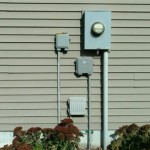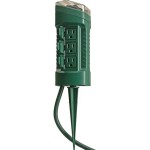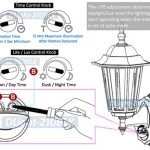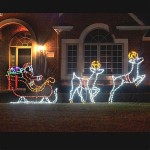Outdoor Wireless Lighting Systems: A Comprehensive Overview
Outdoor wireless lighting systems represent a significant advancement in landscape and security lighting, offering flexibility, ease of installation, and energy efficiency. Unlike traditional wired systems that require extensive trenching and electrical connections, wireless systems operate on batteries or solar power, communicating with each other and a central control unit via radio frequency (RF) or other wireless protocols. This article will explore the various aspects of outdoor wireless lighting systems, including their components, advantages, applications, and factors to consider when selecting and implementing them.
Components of Outdoor Wireless Lighting Systems
A typical outdoor wireless lighting system consists of several key components working in concert to provide illumination. These components include the light fixtures themselves, a central control unit, communication modules, power sources, and optional accessories like motion sensors or timers.
Light Fixtures: Wireless light fixtures can take various forms, including pathway lights, spotlights, floodlights, and decorative lanterns. These fixtures are engineered to be weatherproof and durable, capable of withstanding outdoor elements such as rain, snow, and extreme temperatures. The light source can be LED, which is energy-efficient and long-lasting, or other lighting technologies. The selection of light fixtures depends on the specific lighting requirements of the outdoor space, including the desired brightness, color temperature, and beam angle.
Central Control Unit: The central control unit serves as the brain of the system, managing and coordinating the operation of all connected light fixtures. It communicates wirelessly with each fixture, allowing users to control individual lights or groups of lights. The control unit typically offers features such as dimming, scheduling, and remote access via a smartphone app or web interface. Advanced control units may also integrate with other smart home systems, enabling automated lighting scenarios based on time of day, motion detection, or other triggers.
Communication Modules: Each light fixture and the central control unit are equipped with a communication module that enables wireless communication. These modules typically use RF technology, such as Zigbee or Z-Wave, which are designed for low-power, short-range communication. Other wireless protocols, such as Wi-Fi or Bluetooth, may also be used, depending on the range and bandwidth requirements of the system. The communication module ensures reliable and secure communication between the light fixtures and the control unit, allowing for seamless control and monitoring.
Power Sources: Wireless light fixtures are generally powered by batteries or solar panels. Battery-powered lights are suitable for locations where access to sunlight is limited, while solar-powered lights offer a sustainable and cost-effective energy source. Battery-powered systems require periodic battery replacement, which can add to the maintenance cost. Solar-powered systems, on the other hand, rely on sunlight to charge their batteries, making them environmentally friendly and reducing the need for manual intervention. The size and capacity of the batteries or solar panels are determined by the energy consumption of the light fixture and the desired runtime.
Optional Accessories: A variety of optional accessories can be added to enhance the functionality and convenience of outdoor wireless lighting systems. Motion sensors can be used to trigger lights when movement is detected, providing increased security and energy savings. Timers allow users to schedule the lights to turn on and off at specific times, creating the illusion of occupancy and deterring intruders. Remote controls provide a convenient way to control the lights from a distance, while smartphone apps offer advanced features such as dimming, scheduling, and remote monitoring.
Advantages of Outdoor Wireless Lighting Systems
Outdoor wireless lighting systems offer several advantages over traditional wired systems, making them an attractive option for homeowners, businesses, and municipalities. These advantages include ease of installation, cost savings, flexibility, energy efficiency, and enhanced security.
Ease of Installation: Wireless lighting systems are generally easier to install than wired systems, as they do not require trenching or electrical connections. This reduces the labor costs associated with installation and minimizes disruption to the landscape. Wireless lights can be easily positioned and repositioned as needed, without the need for extensive wiring. This makes them ideal for DIY projects and for situations where flexibility is important.
Cost Savings: While the initial cost of wireless lighting systems may be slightly higher than wired systems, the long-term cost savings can be significant. Wireless systems eliminate the cost of trenching, wiring, and electrical connections, as well as the ongoing cost of electricity. Solar-powered systems, in particular, can significantly reduce energy bills and provide a return on investment over time. Reduced maintenance costs due to the long lifespan of LED lights further contribute to overall cost savings.
Flexibility: Wireless lighting systems offer unparalleled flexibility in terms of placement and control. Lights can be easily moved and repositioned to accommodate changing needs or preferences. The ability to control individual lights or groups of lights remotely allows for customized lighting scenarios and enhanced security. The integration with smart home systems further enhances flexibility, allowing for automated lighting based on time of day, motion detection, or other triggers.
Energy Efficiency: Wireless lighting systems typically use LED lights, which are highly energy-efficient compared to traditional incandescent or halogen bulbs. LED lights consume significantly less energy and have a much longer lifespan, reducing the need for frequent replacements. Solar-powered systems provide a sustainable and renewable energy source, further reducing the environmental impact of outdoor lighting. The ability to dim or turn off lights remotely also contributes to energy savings.
Enhanced Security: Outdoor lighting plays a crucial role in enhancing security and deterring crime. Wireless lighting systems can be used to illuminate pathways, driveways, and other outdoor areas, making it easier to see and reducing the risk of accidents. Motion-activated lights can be used to deter intruders and alert homeowners to potential security threats. The ability to control lights remotely allows homeowners to create the illusion of occupancy, even when they are away from home.
Factors to Consider When Selecting and Implementing Outdoor Wireless Lighting Systems
When selecting and implementing outdoor wireless lighting systems, it is important to consider several factors to ensure optimal performance, reliability, and longevity. These factors include range, power source, weather resistance, security, and compatibility.
Range: The range of the wireless communication between the light fixtures and the central control unit is a critical factor to consider. The range should be sufficient to cover the entire outdoor area that needs to be illuminated. Obstacles such as walls, trees, and fences can reduce the range of the wireless signal, so it is important to take these factors into account. Systems using mesh networking can often extend the range, as each light fixture can act as a repeater, relaying signals to other fixtures and the control unit. Signal strength should be tested after installation to ensure reliable communication.
Power Source: The choice between battery-powered and solar-powered light fixtures depends on the availability of sunlight and the desired level of maintenance. Solar-powered lights are ideal for locations with ample sunlight, while battery-powered lights are suitable for shaded areas. The battery capacity should be sufficient to provide adequate runtime, and the batteries should be easily replaceable. For solar-powered lights, consider the panel size and charging capacity to ensure sufficient power generation during different seasons.
Weather Resistance: Outdoor light fixtures must be able to withstand the elements, including rain, snow, wind, and extreme temperatures. Look for fixtures with a high IP (Ingress Protection) rating, which indicates the level of protection against dust and water. Fixtures should be made of durable materials that are resistant to corrosion and UV damage. Consider the climate in your region when selecting light fixtures, and choose models that are specifically designed for outdoor use.
Security: Wireless lighting systems are vulnerable to hacking and unauthorized access, so it is important to choose systems with robust security features. Look for systems that use encryption and authentication protocols to protect the wireless communication. Change the default passwords and usernames of the control unit and light fixtures to prevent unauthorized access. Regularly update the firmware of the control unit and light fixtures to patch security vulnerabilities. Consider using a separate Wi-Fi network for your smart home devices, including your wireless lighting system, to isolate them from your main network.
Compatibility: If you plan to integrate your wireless lighting system with other smart home devices, it is important to ensure compatibility. Look for systems that use standard wireless protocols such as Zigbee or Z-Wave, which are widely supported by smart home hubs and devices. Check the compatibility list of your smart home hub before purchasing a wireless lighting system. Consider the future scalability of the system and choose a system that can support additional light fixtures and accessories as needed.

The 3 Best Smart Outdoor Lights For Backyards Of 2024 Reviews By Wirecutter

Ring Lighting Indoor Outdoor Home Switches And Bulbs

The 3 Best Smart Outdoor Lights For Backyards Of 2024 Reviews By Wirecutter

Outdoor Smart Lighting System 300w Led Street Light With Portable Solar Panels China Stadium Luminaire Garden Made In Com

Hamilton Mwm 4ch Pskit Mercury Air Wireless Outdoor 4 Channel Lighting Control Kit Gil Lec

Ring Lighting Indoor Outdoor Home Switches And Bulbs

Smart Outdoor Lighting Hue Philips Us

Smart Outdoor Lighting Hue Philips

Outdoor Smart Lighting System 300w Led Street Light With Portable Solar Panels China Stadium Luminaire Garden Made In Com

Ge Lightgrid Wireless Controls Fisher Lighting And







